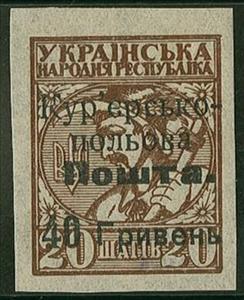Stamp: Ukrainian peasant (Ukraine 1920)
Ukrainian peasant (Ukraine 1920)
26 August (Ukraine ) within release Courier Field Post issue goes into circulation Stamp Ukrainian peasant face value 40 Ukrainian hryvnia
| Stamp Ukrainian peasant in catalogues | |
|---|---|
| Stamp Number: | Sn: UA M12 |
Stamp is vertical format.
20 shahiv stamp of 1918 surcharged "Кур'єрсько- польова Пошта. 40 Гривень" in black Issued for use on registered mail between the Ukrainian government-in-exile at Tarnów, Poland and its military units in Ukraine during the Ukrainian-Soviet War.Also in the issue Courier Field Post issue:
- Stamp - Allegorical Ukraine face value 10;
- Stamp - Allegorical Ukraine face value 20;
- Stamp - Allegorical Ukraine face value 40;
- Stamp - Inscription of value face value 10;
- Stamp - Inscription of value face value 20;
- Stamp - Inscription of value face value 40;
- Stamp - Trident emblem (tryzub) face value 10;
- Stamp - Trident emblem (tryzub) face value 10;
- Stamp - Trident emblem (tryzub) face value 20;
- Stamp - Trident emblem (tryzub) face value 20;
- Stamp - Trident emblem (tryzub) face value 40;
- Stamp - Trident emblem (tryzub) face value 40;
- Stamp - Trident emblem (tryzub) and text face value 40;
- Stamp - Ukrainian peasant face value 10;
- Stamp - Ukrainian peasant face value 20;
- Stamp - Ukrainian peasant face value 40;
Stamp Ukrainian peasant it reflects the thematic directions:
Agriculture is the cultivation and breeding of animals, plants and fungi for food, fiber, biofuel, medicinal plants and other products used to sustain and enhance human life.[1] Agriculture was the key development in the rise of sedentary human civilization, whereby farming of domesticated species created food surpluses that nurtured the development of civilization. The study of agriculture is known as agricultural science. The history of agriculture dates back thousands of years, and its development has been driven and defined by greatly different climates, cultures, and technologies. Industrial agriculture based on large-scale monoculture farming has become the dominant agricultural methodology.
A coat of arms is an heraldic visual design on an escutcheon (i.e. shield), surcoat, or tabard. The coat of arms on an escutcheon forms the central element of the full heraldic achievement which in its whole consists of shield, supporters, crest, and motto. A coat of arms is traditionally unique to an individual person, family (except in the United Kingdom), state, organisation or corporation.
Headgear may be worn for protection against cold (such as the Canadian tuque), heat, rain and other precipitation, glare, sunburn, sunstroke, dust, contaminants, etc. Helmets are worn for protection in battle or against impact, for instance when riding bicycles or motor vehicles. There are also hats that are worn for protection from the cold
A man is an adult male human. Prior to adulthood, a male human is referred to as a boy (a male child or adolescent).
A symbol is a mark, sign, or word that indicates, signifies, or is understood as representing an idea, object, or relationship. Symbols allow people to go beyond what is known or seen by creating linkages between otherwise very different concepts and experiences. All communication (and data processing) is achieved through the use of symbols. Symbols take the form of words, sounds, gestures, ideas, or visual images and are used to convey other ideas and beliefs. For example, a red octagon is a common symbol for "STOP"; on maps, blue lines often represent rivers; and a red rose often symbolizes love and compassion. Numerals are symbols for numbers; letters of an alphabet may be symbols for certain phonemes; and personal names are symbols representing individuals.





